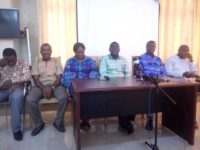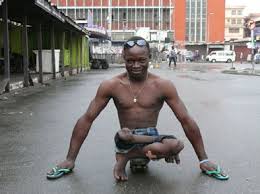Did you know that the Abrahamic religions sprung from the ancient spiritual ideas of Afrika? Oh yes, it was black men from Afrika who wrote the Bible, the Tanach and the Quran. Then the white guys covered up the history, changed a lot so you would lose your power and said it was they who had the Truth. But they did not stop there; they took you as slaves and forced their ideas upon you after calling you savages.
Did you know the first university in the world was in Mali? Did you know that it was black Africans who gave Europe its early civilisations.
There are white men and women who are searching and seeking spiritual truth in the ancient traditions of Afrika but you blacks whose ancestors had those spiritual truths are still slaves to white man’s junk and lies. It is my view that you need to turn back to your ancient roots
Did you know that Christianity, Judaism and Islam are very different today from what they were a long time ago?
Here’s an interesting account you really should read and consider well……
Yoga’s Role In Dr. David Cumes’ Journey From Surgeon To Sangoma
“WHAT ARE YOU DOING? THIS IS CRAZY. I’m a surgeon!” Dr. David Cumes recalled saying to himself while sitting in an African hut facing what could be considered off-putting rite-of-passage rituals, like sacrificing chickens and shaking, sweating and screaming while being possessed. Cumes, a respected urologist with a private practice in Santa Barbara, was back in his native South Africa preparing to become a sangoma, a destiny that he had been attempting to skirt for many years.
Sangomas, medical intuitives, indigenous healers or shamen, as they also are known, are those who are “possessed by the virtue of the bones,” according to Cumes. Sangomas are aided by their ancestors, who come to them via dreams, signs such as animal sightings that the ancestors send and during a divination process that sangomas employ to help their patients.
During the divining session, the sangoma “throws the bones,” which are a collection of items in his or her kit, some of which are bones, but which also can include objects like coins, teeth, beads and shells. A question is posed before the throw and depending on how the objects fall or based upon the position of items that symbolize specific things, the sangoma is able to intuit information about the patient and can make appropriate recommendations.
 Not all patients are seeking medical advice. Many employ the services of a sangoma to help them with various life situations like career and financial issues, personal relationships or educational goals. Think of the sangoma as a conduit to the ancestors, as someone who can shed light on cloudy or troubling scenarios. Dr. Cumes threw the bones for me in his yurt in Santa Barbara to discern in which country I should pursue a law degree. The yurt has a mystical vibe and is filled with woven pots, various dried plant remedies, horns, antlers, beads and other relics and treasures from Cumes’ travels. Think of an indigenous apothecary of sorts. Patients speak their name to the bones and add a pinch of snuff to them before they are thrown so that the ancestors know for whom they are divining.
Not all patients are seeking medical advice. Many employ the services of a sangoma to help them with various life situations like career and financial issues, personal relationships or educational goals. Think of the sangoma as a conduit to the ancestors, as someone who can shed light on cloudy or troubling scenarios. Dr. Cumes threw the bones for me in his yurt in Santa Barbara to discern in which country I should pursue a law degree. The yurt has a mystical vibe and is filled with woven pots, various dried plant remedies, horns, antlers, beads and other relics and treasures from Cumes’ travels. Think of an indigenous apothecary of sorts. Patients speak their name to the bones and add a pinch of snuff to them before they are thrown so that the ancestors know for whom they are divining.
However natural the process is for Cumes now, becoming a sangoma was by no means a conventional step in the career of a Stanford-trained physician. Cumes credits his regular Ashtanga Yoga practice with getting him in touch with the kundalini energy that primed him for such an undertaking.
Cumes studied allopathic medicine in both South Africa and the US and while he was cognizant of the existence of sangomas, and regularly consulted them, he never imagined that he would become one, the idea initially clashing with his scientific training.
The ancestors work in mysterious ways though, and during his visits with African sangomas, the bones continually told him that his ancestors were calling him to the path and that the headaches he suffered from were a symptom of his refusal to become initiated. He simply wasn’t ready to make the jump at the time, despite finding himself increasingly restless in his Western medical practice.
Cumes attempted to combat the nagging feelings through his Yoga practice, which he first discovered in 1987 at the White Lotus Foundation, as well as through mind-clearing and restorative trips into nature. While the energy of kundalini is the vehicle which helps Cumes enter “the Field” as he categorizes it, which, in turn, enables him to do the work of a sangoma, nature was the first step in becoming aware of the kundalini experience. Perhaps it is what helped him get in touch with his path as a sangoma, the path that he likes to say “chose him.”
It was the natural forays that eventually led him to start a company called Inward Bound Healing, which takes groups of people into the wilderness in Africa and Peru.
While leading trips to Africa, he continued to consult with different, unrelated sangomas to determine if his guided trips would be fruitful and if there were things he needed to be aware of and treat with caution. Over and over, he was impressed with their ability to have a reliable pulse on the happenings of his groups and as before, that they were able to tell him things about himself that there was no way that they could have known otherwise.
Along the way, Cumes’ reluctance to join the tradition slowly softened, also aided by time spent with the San Bushmen in the Kalahari Desert and his treks through the sacred valleys and mountains in Peru amidst the curanderos, the South American shamans.
I first learned of Dr. Cumes’ work through his daughter Romi, a friend and fellow Yoga teacher, and when an opportunity to go to South Africa presented itself, I spoke with him about arranging a sangoma visit. While his sangoma wasn’t available, I was able to meet Dr. Cumes in person and hear his story firsthand.
One of the many things that impressed me about the spry and genuine physician is the manner in which he applied his methodical medical training to all aspects of his initiation. Like a scientist, he tested each step along the way, refusing to believe in things blindly, requiring his own evaluation of veracity before signing on, which allowed him to move from skepticism to acceptance over time; a choice that ended up strengthening his surgical practice through the added insight imparted by his eventual sangoma practice. He applied the same care to his inquiry into yoga and meditation practices, which honed his intuition regarding the powerful forces of kundalini energy.
Cumes found that the concept of kundalini was present in many corners of the world, which resonated with him. “The yogis call the primal, feminine energy of the cosmos the Kundalini, the San call it Num and the Zulu call it Umbilini,” he said, going on to state that “When I came to California, people everywhere were talking about kundalini experiences, but rarely were they actually having them.”
He found the San Bushmen to have the most immediate access to a kundalini state, an incredible phenomena for most. However, the San are a rarity being largely illiterate and living as true hunters and gatherers in one of the harshest environments in the world. Despite multiple stays with the San, Cumes barely scratched the surface of their knowledge and realized it would take years to be able to glean more of the vital information they possess for living (and healing) in harmony with nature. He was especially taken with their overall happiness and health, despite an almost total lack of material possessions that we in the west would deem integral to survival.
Cumes had long sought refuge in nature having grown up spending summers on family farms deep in the African wild. His time in the elements instilled in him a deep sense of the rejuvenative power of nature and he found it imperative to return to the wilderness regularly in order to re-balance and heal himself. Especially after the rigors of medical school, a system which he describes as turning out wounded healers who go on to have stressful lives mired in the disconnected bureaucracy of the world of modern medicine.
He found everyday polarities to be far more pronounced in nature than when living in an urban setting. Day, night, hot, cold, dry, wet, satiated and hungry all seemed more tangible when in the wild, leading to an elevated state of awareness Cumes termed “wilderness rapture.” It was here that he was able to get in touch with his most authentic self and tone himself to be able to handle the demands of being a doctor, one who now possessed more of a holistic approach, despite his self-admitted empirical left-brained tendencies.
Cumes freely acknowledges that it was his yoga practice that helped harness his kundalini energy both in Africa, as a preparation for the rigorous initiation education, as well as for maintaining the equanimity needed for a day in the operating room in Santa Barbara. And while he did enter a trance channel during his initiation, aided by a team of drummers that helped cull the proper environment, it was decreed that he didn’t need to experience a spirit possession after all. The ancestors concluded that the bones and the dreams would be the way in which he healed; his yogic practices sufficient to keep him in tune.
As a result, he maintains that some sort of inner-directed, spiritual practice is necessary for anyone seeking self-growth and healing. Additionally, his Yoga practice keeps him connected to the spirit world at large, even being so far from Africa much of the time, enabling him to attain information to help patients in both his office and yurt in a more intuitive way.
In his urology practice, he might ask the bones who he should or shouldn’t operate on or who might be better off seeing another physician. A hybrid patient type has also materialized; those seeking his expertise with the bones to shed light on their illnesses that a normal western doctor might not be able to elicit.
When he first opened his doors as a sangoma, 90% of his patients were in his urology practice, 10% in his sangoma practice. The numbers are quickly approaching a 50-50 split and he hopes to practice more spirit and indigenous medicine in the future.
Cumes’ experience as a sangoma also taught him about a sensitive topic for many in the spiritual world – the dark side. The Yoga world has certainly seen its share of disgraced gurus and Cumes is convinced that a strong spiritual practice, including connecting with the kundalini field, is a good way to be able to discern what are positive and what are negative forces. Part of the sangoma’s work is to ward off evil spirits, trickster ancestors and curses and it is his dedication to his practice that enables him to accurately assess these dueling sides. The more we practice, the more adept we can become at tuning into our own inner-strengths to receive truth, clarity and our unique intuitive messages.
Dr. Cumes’ Tips for Developing a Relationship with Your Ancestors:
We all have spirit guides and when we cultivate a relationship with them, they will come to our aid. An essential part of this practice is a love connection with the ancestors. “Love is the catalyst that goes through the veil” says Cumes, and it is important to foster relationships with ancestors who love you – even if they had already passed on before you entered this world. Many ancestors will see things in you that remind them of themselves, which will bond them to you. As you move deeper into this practice, your intuition will tell you which ancestors, as well as which special mentors and friends, that you should create relationships with on this level.
• Create an altar or shrine with photos of the people that you want to communicate along with items of relevance.
• Add inviting objects, representative of your culture or religion.
• Use a white cloth (the color of the ancestors) on the base of the altar.
• Begin a daily conversation with ancestors by lighting sage or a candle.
• Make offerings: a pinch of tobacco, a flower, or a feather from a hike.
• Honor them by name and thank them for all that they have already done for you, eventually invoking their guidance.
• Be specific in what you ask for and about; free will is the cosmic law and the ancestors can’t interfere with that. You won’t have much luck if you ask them to send you a dream to tell you what to do with your life, but if you pose a directed question, the message you receive has a better chance of being clear.
• The ancestors may give you dreams, bouts of intuition and for the nature-bound, power animal signs like the red tailed hawk
• Hold your ancestors close to your heart like a beloved friend or family member. Do not take them for granted. They are your link to the spirit world and know when you stray from your true path or promises.
• Broaden the ancestor relationship at holidays by making food offerings to them and inviting them into the celebration, making sure to explain their presence and importance to any children in attendance.
While this practice can be hard to quantify initially, things will come together and many people find that they don’t feel as alone in the world as they deepen relationships in the spirit realm.
For more information on ancestral relationships in the dream continuum, read more at:layogamagazine.com.
Dr. David Cumes, an Ashtanga practitioner, is also an author, physician and indigenous healer based in Santa Barbara, California. For more information visit: davidcumes.com.
Amy Wong wishes the thank Dr. Cumes, his family and the ancestors, especially her paternal great grandfather whom the sangomas told her follows her around the world and her maternal great grandmother, who was a healer. She is currently cultivating a relationship with her ancestors, paying homage to them at an altar in her kitchen, hoping that they continue to light the way as she forges a new life path. This summer Amy is traveling and missing spreadsheet camp at Burning Man, but she sends good wishes to the playa via sage smoke: amywong1@mac.com.





